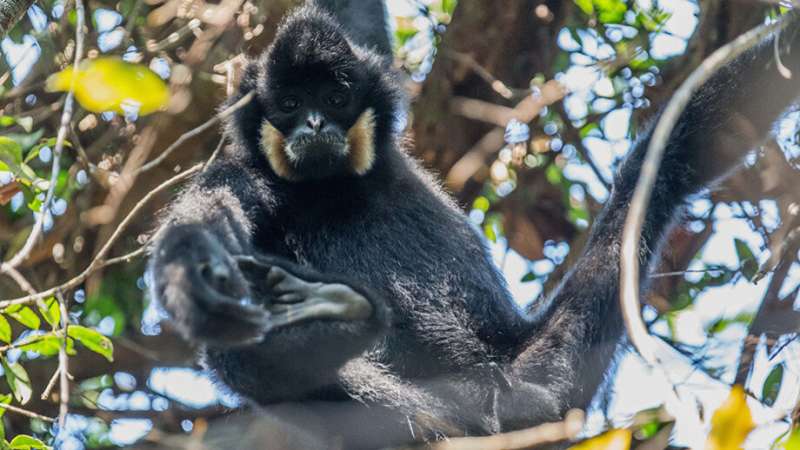Gibbons need protection from COVID-19, too

Experts studying how tourism affects wild gibbons say visitors should wear PPE masks and have health checks before visiting them.
While tourism to wild gibbon populations halted with the first COVID-19 lockdowns, tour operators in Cambodia and China are gearing up to resume visits.
The recommendations build on world-first research on wild gibbon populations in Cambodia and China, which shows the apes significantly alter their behavior, to their own detriment when tourists are present.
Instead of resting and socializing, gibbons spent more time on the look-out for danger and displayed stress and anxiety behaviors when tourist groups followed them.
ANU researcher Jessica Williams said her studies showed gibbons were trading off their rest time to monitor an unfamiliar situation.
"Scanning the landscape is one way animals monitor their environment and detect danger. When tourists are present, we observed the gibbons spent more time scanning compared to when tourists were absent," Ms Williams said.
"This increase in scanning was coupled with a decrease in time spent resting and rest is essential to maintaining normal brain function and immune responses. If the gibbons' immune system is affected it can have negative side-effects. It can lead to shortening their life or making them more susceptible to catching diseases—and because we're all primates, they may be able to catch something from us."
Ms Williams said COVID-19 might be one of the diseases gibbons could be susceptible to.
"Due to a lack of research, we don't know for sure if the small apes; gibbons and siamangs can catch diseases like COVID-19 from humans. But disease transmission from and to humans is well-documented in the great apes like gorillas and chimpanzees," she said.
"Because gibbons being used for tourism could suffer reduced immunity in the face of large and frequently changing groups of people entering their environment, we can't take any chances. Once a disease has been transmitted it spreads through the entire population."
As well as temperature checks and wearing protective gear, Ms Williams' guidelines recommend limiting visits to once a day, with total group numbers of eight and only when the gibbons are naturally active.
"Our research showed how tourism was affecting the gibbons before COVID-19 hit. Before it starts up again, we want tour operators to pause and re-set expectations for tourism and visitors by re-designing their programs based on this new research," Ms Williams said.
"We're not against 'Nature Based Tourism.' In fact, we know it can create jobs and revenue and has the potential to combat destructive practices like logging or poaching. We also know these programs were set to boom in Asia and so before things resume and expand, we want to make sure Nature Based Tourism programs are better designed to prioritize the welfare of the animals."
Jessica Williams' research was conducted on northern yellow-cheeked crested gibbons (Nomascus annamensis) at Veun Sai-Siem Pang National Park in Cambodia and Skywalker gibbons (Hoolock tianxing) at Mt Gaoligong National Nature Reserve, China and is published in Animal Biology.
Her guidelines to protect wild gibbons from tourism will be published in the forthcoming edition of the Journal of Sustainable Tourism.
More information: Northern yellow-cheeked crested gibbons (Nomascus annamensis) travel and scan more at the cost of rest when in the presence of tourists. Animal Biology. doi.org/10.1163/15707563-bja10040
Provided by Australian National University




















